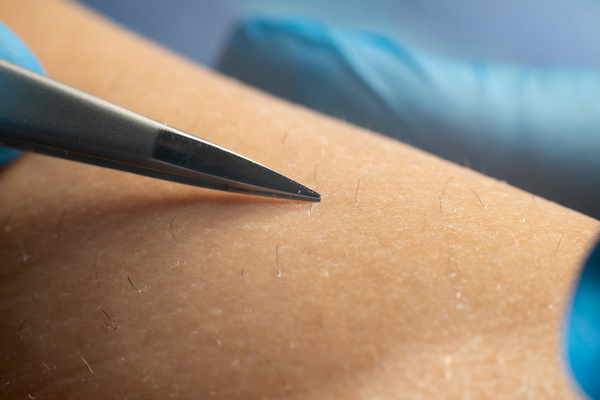No hair removal treatments work overnight, and the same holds true for Electrolysis hair removal. This method involves a series of meticulously administered sessions to achieve lasting results, making it essential for individuals seeking a more permanent solution.
Understanding that the efficacy of this treatment is rooted in the gradual disruption of hair follicles, it becomes evident that patience is paramount throughout the treatment journey. So, how long does electrolysis take?
Let us delve into the details below to understand the treatment process.
What is Electrolysis Hair Removal?
It is a permanent hair removal technique that uses a thin needle to penetrate the skin via the hair follicle. Medical electrolysis devices are known as epilators — the needle is often finer than a hair. Once inside, an electrical current is run down the needle or wire to destroy the hair root by heating it.
In most cases, the hair follicle is permanently damaged, preventing future hair growth. The existing hair will fall out in the hours to days after the procedure.
Electrolysis for hair removal is a safe and FDA-approved procedure — the only FDA-approved permanent hair removal treatment currently available.
As this treatment works on one follicle at a time, it’s typically reserved for small areas, like eyebrows, upper lip, or chin. More extensive electrolysis is possible — for example, the underarms or bikini line — but it is tedious and somewhat painful.
Generally, laser hair removal is the chosen method for darker hair and larger areas, whereas Electrolysis is reserved for lighter, finer hair and smaller areas.
How long does Hair Removal Electrolysis take?
An individual session will be longer or shorter depending on the number of hairs being treated. The more hairs, the longer the session. The treatment lasts anywhere between 15 minutes and one hour.
To complete your course — seeing a significant and permanent hair reduction — several appointments are needed — for several months to a year.
Appointments are typically scheduled weekly or biweekly. Some people will require more sessions due to the coarseness and density of their hair. You’ll also need to take into account how fast your hair grows. Your age, nutrition, genetics, and overall health determine the growth rate of hair.
Why does it take multiple sessions?
To comprehend why it requires multiple sessions for permanent hair removal electrolysis to yield lasting results, we need to delve into the basics of hair growth. When hair grows from a follicle, it does so in four stages — anagen, catagen, telogen, and exogen. Different hair follicles are in different stages at any one time — some are growing, others are not.
This treatment targets visible hairs in the growing stages, but dormant follicles can still start growing between sessions. New hair growth post-session doesn’t indicate treatment failure.
Multiple sessions are needed to target all the hairs as they progress through the stages. Over time, you’ll start to see a steady reduction in hair, leading to permanent hair removal.
How long until you’ll see results?
You’ll see results from the very first electrolysis hair removal session. Most hairs are in the growth phase, meaning targeting them is easy. The first session, therefore, is when most hair is removed.
After your first session, it’s not uncommon to see a slight reddening of the skin. Many hairs will fall out, leading to noticeable hair thinning. If these hairs do regrow, they appear thinner and sparser than before. In most cases, however, the hair is not completely gone.
After three to five sessions of electrolysis for hair removal, you are guaranteed to see permanent and impressive results. By this point, most initial hairs have been removed — further treatments target the lingering hair follicles.
After fifteen to thirty treatments, you should see complete hair loss with little to no hair growing back in the area. Recurrent hair growth — occurring within weeks of the last treatment – means further sessions are needed. Extra appointments are normally needed if your hair is thicker or darker than most.
How much can hair regrow after Electrolysis?
Maintaining a consistent hair removal electrolysis schedule is crucial. Why? Because at any given time, 40 percent of hair follicles are resting, which can result in additional regrowth.
Moreover, in certain cases, the epilator may not effectively damage the hair follicles — the follicle may be distorted or not adequately heated.
With 500 to 1,000 hair follicles per square inch, it’s hard to produce perfect hair removal in only a handful of sessions.
After the first three to five sessions of permanent hair removal electrolysis, you will see noticeable “false” hair regrowth. After this point, enough resting hair follicles are damaged that permanent hair thinning is readily noticeable.
Certain areas also lead to more regrowth than others:
- Chin, front of the neck, upper lips, and cheeks often tend to grow more new hair as a person ages, depending on their genetics or hormonal levels.
- Chest, ears, back, feet and toes, and breasts typically require fewer follow-up sessions after the initial course of treatment.
- Legs, eyebrows, arms, underarms, legs, and abdomen rarely, if ever, require follow-up treatment on a completed area.

Unveiling Essential Insights into Electrolysis for Hair Removal
This exclusive FDA-approved method for permanent hair removal uses a heated needle to damage hair follicles. Achieving lasting results may necessitate fifteen to thirty sessions, with noticeable improvements after three to five sessions.
Multiple sessions are crucial to target hair follicles in their resting stage, particularly in the initial phases. Depending on the treated area’s size, session durations vary from 15 minutes to one hour. Individuals with darker, coarser, and thicker hair may need more electrolysis hair removal sessions than those with different hair characteristics.
For effective and lasting results, trust the expertise of our professionals here at Alite Laser Hair Removal. Contact us now to schedule your sessions and embark on your journey to smooth, hair-free skin.


